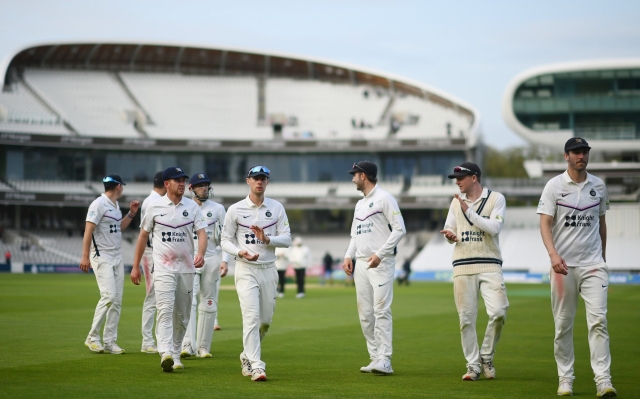 Jason Roy has set his sights on America. Photo: Getty Images/Steve Bardens. Loyalty in cricket has endured for 150 years — still today
Jason Roy has set his sights on America. Photo: Getty Images/Steve Bardens. Loyalty in cricket has endured for 150 years — still today
With the domestic test season kicking off on Thursday with England playing Ireland at Lord's and then playing the Australians, it is time to rethink the state of the format. Until there is evidence to the contrary, English Test cricket remains in the «Buzzball» era, where Test cricket is fast and furious not only in an attempt to win but to continue to draw crowds.
Press briefings from the England camp talk about looking for a two-day win: good luck with that and pity MCC, who will lose two days of revenue as a result. Perhaps when the main course arrives — a series against Australia, with five Tests squeezed into just over six weeks from mid-June to the end of July — Tests are predicted to last three or even four days. This is further proof that, with the glut of one-day cricket we are now subjected to, Test cricket is changing.
But then everything changes in cricket, with inevitable consequences for test play. The American League is about to start (they may have tried to kick us out in 1776, but we knew they would come to their senses eventually), and since the summer in the United States mostly happens at the same time as us, this could lead to to that some of our players. Jason Roy, who was by no means a regular in the Tests, has stated his own desire to play Major League cricket in the US and the League is said to be trying to recruit various promising but not yet closed English players. Thus the emasculation of the English game continues: first the county championship is reduced to the level of competition more familiar a few decades ago among the second XI districts, and now white-ball cricket is hunted down.
Saudi Arabia is also thinking about the competition. Soon the brightest and most experienced British overnight cricketers will be able to play all year round in India, the Middle East, the United States and perhaps even, when they have nothing else to do, in England itself.
Where is it? leaves our test cricket, one can only guess. Many of our potentially top English players may soon be out of contact with the English counties as they loan themselves out to high paying franchises around the world. Such is the modern world, and it does not fit well with the county and national system of England, which has worked in much the same way since the 1870s.
 Middlesex playing in Somerset at Lord's earlier this month. Photo: Getty Images/Alex Davidson
Middlesex playing in Somerset at Lord's earlier this month. Photo: Getty Images/Alex Davidson
No one blames cricketers for making money where and when they can: but such a view is inevitably incompatible with the traditional system of loyalty to counties and nations. That is why I have been arguing for years in these pages for a two-code system of short and full cricket that allows individuals, districts and national authorities to have a clear view of their talent pool. Indeed, it would allow players who are still equal to first-class cricket, but too old or worn out to play white ball, to carry their considerable experience into Test cricket at a later age, if they had the energy and talent to broaden their horizons. career.
But as these new leagues develop, it seems to me more and more obvious that if they continue to flourish, the current system will not last long.
Roy, who had a contract with the ECB, got rid of him to go play in America. Thus the current system, with all its contractual arrangements and supposed loyalty, is no longer particularly viable. The counties negotiate promising young cricketers who, as soon as they approach the peak of their talent, are withdrawn and given central contracts while they play Test and white ball cricket for England.
Given that some do one thing and not another, this is already a sign of the evolution of the two-code system, and it will become more noticeable. What will also become more visible is that young players are formed in the county system and then leave, not to sign a contract with central England, but to play in the international flying circus that flutters from one national league Twenty20 to another. There will soon be many more opportunities for such an existence, and it is bound to affect Test cricket both here and abroad, siphoning off some of his talent more or less permanently — until boredom or hard work sets in. the physical toll from endless short games is starting to register.
Buzzball is one way to make Test cricket more attractive, but not the only one. Tickets are too expensive, and their cost will become even lower if the best players play franchised cricket abroad. The schedule is terrible, with so few tests during the long school holidays. And the game remains too slow. It was a pleasure to spend the day at Lord's this month on the first day of the championship game between Middlesex and Somerset, at which a healthy crowd (and not just in the enclosures) enjoyed an energetic display of patrons (who ended up winning comfortably, by a few innings), and he was reminded of one main reason Test cricket had become so unsatisfactory: slow interest rates.
 John Simpson, the Middlesex bat, is applauded as he climbs the pavilion steps at Lord' ;s v. Somerset . Credit & Copyright: Getty Images/Alex Davidson
John Simpson, the Middlesex bat, is applauded as he climbs the pavilion steps at Lord' ;s v. Somerset . Credit & Copyright: Getty Images/Alex Davidson
In county play, where there is determination to switch sides quickly between overs and keep playing, the game is constantly consuming. No endless meetings between players; and there were no reviews that did an excellent job of undermining the judicial profession. Supposedly, with the development of artificial intelligence, we are only a season or two away from robot judges who can make ironclad decisions on weight, lag or lag, and the game can race. on: unless, of course, we can return to that happy state where human error is treated as an integral part of the game, and everyone learns to live with it. Not least that's why cricket was once seen as a metaphor for life, which is known to have its injustices.
So we can have a tumultuous summer of test cricket, at least with pyrotechnic strikes. part of the home side; but it's unclear how much more will follow. If many of our most talented players choose to join the international cricket circus, can they be sent back to play in the home Tests, or would they even want to if money is their main motivation? How fair is this to local artists who strive to impress and for whatever reason are not attracted to international circuses? And if not a single major international player participates in county cricket, will its already emaciated crowd shrink even further?
These are great strategic questions about the future of an entire top-notch game. If the England and Wales Cricket Board reflects on them, they do an exceptional job of keeping their thoughts to themselves.


















































Свежие комментарии